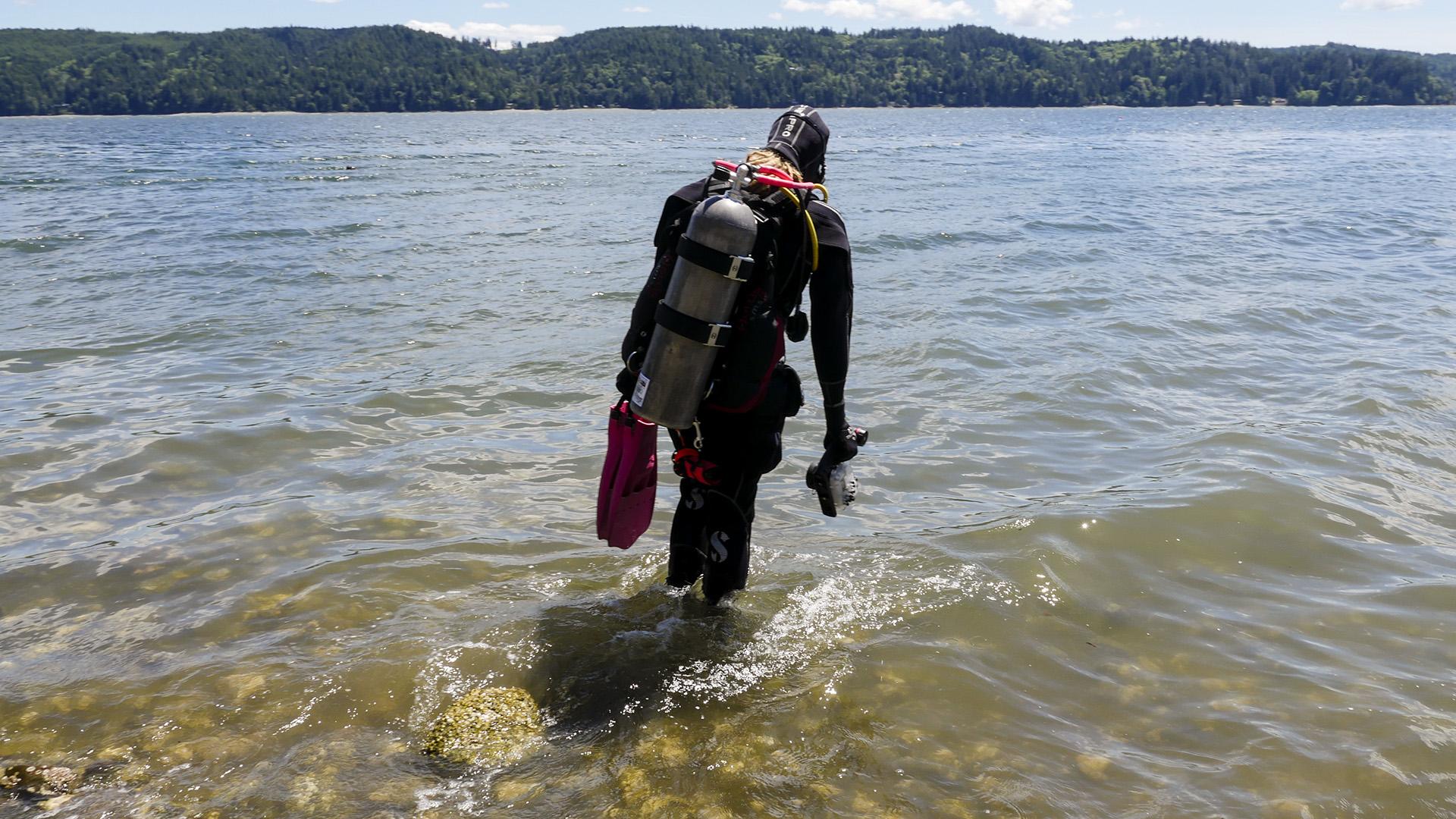
Portland diver Callie Renfro's May 2016 sighting of a sixgill shark in Washington's Hood Canal was one of several such incidents, fueling speculation that the giant shark may be repopulating Puget Sound.
Katie Campbell, KCTS9 / EarthFix
A crisp wind rakes the surface of Hood Canal, a narrow, 68-mile waterway and Puget Sound’s westernmost reach.
A group of divers emerges from the chop and wades ashore. They’ve just finished their first open-water dive.
“Congratulations. You’re certified,” said Callie Renfro, the dive instructor.
Renfro, from Portland, has been diving this popular scuba site for six years and knows the area well. It's rich with the kind of sea life that divers love to encounter; like the wolf eels that have taken up residence in the sunken vessels on the floor of Hood Canal.
WATCH the Wildlife Detectives Documentary 'Mystery Sharks of Seattle' Wednesday, Aug. 3 at 10 pm on OPB Television
“I know the site very well,” she said. “It’s really nice and I’m glad that students get to see something on their first dives.”
On the dive the trainees also spied crabs, rockfish and a big jellyfish. But no one catches a glimpse of the sharks that Puget Sound has become known for: the sixgill.

Portland diver Callie Renfro, in Puget Sound's Hood Canal.
Katie Campbell, KCTS9 / EarthFix
Renfro had heard stories about Puget Sound’s sixgill sharks — named for the number of gill slits on each side of the head. She never imagined encountering these rare and elusive creatures herself. But that’s exactly what happened here a few weeks ago.
“We were just doing a fun dive before class,” she said.
Renfro and her dive partner descended to 100 feet. Their dive lights illuminated the water around them. Then a shadow appeared on the edge of the darkness.
“A sixgill was swimming towards us. I was in complete shock,” Renfro said. “It was 7 or 8 feet long. It swam towards me and got about a foot away from me. I was spooked and thought, ‘That’s too close!’”
It glided past them. Then circled back, making a few more passes.
“I almost wanted to get out of the water. But it was like, ‘Holy crap! This is amazing! Because I know how rare they are to see.”
A sixgill research opportunity
Sixgill sharks can reach lengths of 16 feet — as long as a pickup truck and as wide as a couch. They typically roam the deep ocean, spending their lives in darkness thousands of feet below the surface. Encountering them in shallow water is extremely rare.
But back in the late 1990s and early 2000s divers began regularly encountering sixgills in Puget Sound.
"Pretty much out of nowhere this influx of sharks appeared and we knew nothing about them," said Phil Levin, a sixgill researcher and a senior scientist with the National Oceanic and Atmospheric Administration's Fisheries Northwest Fisheries Science Center.
“What do they eat? We don’t know. How long do they live? We don’t know. How fast do they grow? Couldn’t tell you. This is not like a tiny animal," he said. "This is a big animal and I couldn’t even tell you anything about the basic biology.”
There were more questions: What had caused their sudden appearance? Had changing ocean conditions brought this large, deep-ocean shark to the shores of Seattle? Was climate change the culprit? Or were divers and scientists witnessing something different?
Biologist Jeff Christiansen and a team of researchers from the Seattle Aquarium have been seeking answers. In the early 2000s, the aquarium team started placing bait in the water below the aquarium to attract the sharks. Within minutes of their first attempt, a sixgill emerged from the inky waters. The bait station, in the heart of downtown Seattle's bustling waterfront, quickly became a popular stop for the hungry sharks.
“At the peak of our shark research, we had up to 40 different animals present on a single evening event,” Christiansen said.

Biologist Jeff Christiansen (right) readies a team of Seattle Aquarium divers.
Greg Davis / KCTS9
As sharks wheeled around the bait box, teams of aquarium divers waited for the sharks to swim close, then stuck ID tags to their backs and took tissue samples for analysis. The researchers soon noticed surprising insights — Not only were almost all the sharks juveniles, but the animals appeared to travel together in small persistent groups. Were these companions or mates? Or were the animals hunting in packs?
University and government research teams joined effort with the aquarium to study the sharks. Radio trackers helped determine the sharks were clustering in territories the size of golf courses. For a large shark capable of traveling many miles a day, this was unexpected.
“We sort of expected when we first started this work to be tracking a shark through the channel of Puget Sound,” said Kelly Andrews, a sixgill researcher from the NOAA Fisheries Northwest Fisheries Science Center. “But as it turned out, they just did not go anywhere. They would kind of move around the waterfront of Seattle, but they wouldn’t leave.”
VIDEO VAULT: Oregon Field Guide's 2009 report on sixgill sharks
"Right here in downtown Seattle, in Elliott Bay, this was the center of the sixgill abundance," Levin said.
Genetic analysis of the tissue samples revealed another surprise — Many of the sharks circling about Seattle were related.
“They were brothers and sisters or half brothers and half sisters,” said Shawn Larson, the Seattle Aquarium’s curator of research.
Groups of young siblings clustered together in small groups, the evidence all pointed to a possible explanation: that Puget Sound was an important nursery ground for sixgills. Nursery areas provide safe havens for young sharks to grow and mature. Protecting these areas is essential for shark conservation efforts.
With sharks swarming about the Seattle waterfront, research boomed.
“This was the equivalent of having sharks drive down the street to your lab and just go into the tanks on their own. It was great!” Christiansen said.
Then in 2008, the sixgills all but vanished. Researchers speculated the sharks had left Puget Sound to live their adult lives in the deep ocean. They think there hasn’t been another big group of sharks born here since.
“It’s really a great question as to whether these animals will be coming back to the same waters that they grew up in to give birth,” Christiansen said. “That would be a fantastic piece to add to the puzzle.”
Watching for a comeback
Dayv Lowry has been on the lookout for the sixgills' return. He studies forage fish for the Washington Department of Fish & Wildlife. Lowry and his team use a remote operated submersible to survey the waters of Hood Canal for rockfish, not far from where diver Callie Renfro recently encountered her sixgill.
On a typical dive, the researchers lower the tethered device into the water and monitor the video feed transmitted up to the boat. The sub glides over the sandy bottom through the murky darkness. It passes over the occasional rock and a few fish that look a lot like rocks. The scene becomes monotonous quickly.
But on a couple research trips last year, they came across something out of the norm.

The Washington Department of Fish and Wildlife's Dayv Lowry (right) monitors video transmitted from a remotely operated submersible.
Michael Werner, KCTS9 / EarthFix
“We saw something in the distance, and kind of adjusted and maneuvered and twisted a little bit,” Lowry said. “All of a sudden that something was four feet from the camera and eight feet long.”
In the span of just a couple weeks, the team captured two sixgills on camera, both in Hood Canal.
“They’re not exactly Bigfoot. They’re out there, we know for sure they exist, but in many ways we spend hundreds of hours down there and encounter them so rarely, that they’re almost mythic,” Lowry said.
Could the recent sightings mean another large cohort of sixgills is growing up in Puget Sound? The Seattle Aquarium’s Jeff Christiansen says it’s too soon to say.
“Are we just starting to see the early phase of another batch of sharks moving in?” Christiansen said. “I’m hopeful, but I’m skeptical till the numbers support it.”
For divers like Callie Renfro, they savor the opportunity and hope for more.
“I really thought I would never see one in my lifetime because they are so rare,” Renfro said. “If they are coming back, that’s great. I think it’d be awesome.”
Katie Campbell of KCTS9/EarthFix contributed to this report.